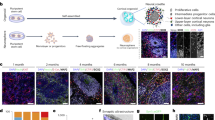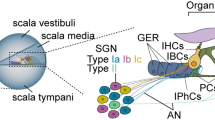Abstract
The cells in the organ of Corti do not exhibit spontaneous cell regeneration; hair cells that die after damage are not replaced. Supporting cells can be induced to transdifferentiate into hair cells, but that would deplete their numbers, therefore impairing epithelium physiology. The loss of p27Kip1 function induces proliferation in the organ of Corti, which raises the possibility to integrate it to the strategies to achieve regeneration. Nevertheless, it is not known if the extent of this proliferative potential, as well as its maintenance in postnatal stages, is compatible with providing a basis for eventual therapeutic manipulation. This is due in part to the limited success of approaches to deliver tools to modify gene expression in the auditory epithelium. We tested the hypothesis that the organ of Corti can undergo significant proliferation when efficient manipulation of the expression of regulators of the cell cycle is achieved. Lentiviral vectors were used to transduce all cochlear cell types, with efficiencies around 4 % for hair cells, 43 % in the overall supporting cell population, and 74 % within lesser epithelial ridge (LER) cells. Expression of short hairpin RNA targeting p27Kip1 encoded by the lentiviral vectors led to measurable proliferation in the organ of Corti and increase in LER cells number but not hair cell regeneration. Our results revalidate the use of lentiviral vectors in the study and in the potential therapeutic approaches for inner ear diseases, as well as demonstrate that efficient manipulation of p27Kip1 is sufficient to induce significant proliferation in the postnatal cochlea.





Similar content being viewed by others
References
Bedrosian JC, Gratton MA, Brigande JV, Tang W, Landau J, Bennett J (2006) In vivo delivery of recombinant viruses to the fetal murine cochlea: transduction characteristics and long-term effects on auditory function. Mol Ther 14:328–335. doi:10.1016/j.ymthe.2006.04.003
Chai R, Xia A, Wang T, Jan TA, Hayashi T, Bermingham-McDonogh O, Cheng AG (2011) Dynamic expression of Lgr5, a Wnt target gene, in the developing and mature mouse cochlea. J Assoc Res Otolaryngol 12(4):455–469. doi:10.1007/s10162-011-0267-2
Chen P, Segil N (1999) p27Kip1 links cell proliferation to morphogenesis in the developing organ of Corti. Development 126:1581–1590
Cruickshanks KJ, Wiley TL, Tweed TS, Klein BE, Klein R, Mares-Perlman JA, Nondahl DM (1998) Prevalence of hearing loss in older adults in Beaver Dam, Wisconsin: the epidemiology of hearing loss study. Am J Epidemiol 148:879–886
Duan M, Mi Q (2010) Local delivery of reporter gene to the cochlea does not spread to brain tissue in an animal model. Acta Otolaryngol 130(1):25–30. doi:10.3109/00016480902963053
Erenberg A, Lemons J, Sia C, Trunkel D, Ziring P (1999) Newborn and infant hearing loss: detection and intervention. American Academy of Pediatrics. Task Force on Newborn and Infant Hearing, 1998–1999. Pediatrics 103:527–530. doi:10.1542/peds.103.2.527
Goslin K, Banker G (1991) Rat hippocampal neurons in low-density cultures. In: Banker G, Goslin K (eds) Culturing nerve cells, 2nd edn. MIT, Cambridge, pp 251–281
Gubbels SP, Woessner DW, Mitchell JC, Ricci AJ, Brigande JV (2008) Functional auditory hair cells produced in the mammalian cochlea by in utero gene transfer. Nature 445:537–541. doi:10.1038/nature07265
Han J, Mhatre AN, Wareing M, Pettis R, Gao WQ, Zufferey RN, Trono D, Lalwani AK (1999) Transgene expression in the guinea pig cochlea mediated by a lentivirus-derived gene transfer vector. Human Gene Therapy 10:1867–1873. doi:10.1089/10430349950017545
Ishimoto S, Kawamoto K, Kanzaki S, Raphael Y (2002) Gene transfer into supporting cells of the organ of Corti. Hear Res 173:187–197. doi:10.1016/S0378-5955(02)00579-8
Izumikawa M, Minoda R, Kawamoto K, Abrashkin KA, Swiderski DL, Dolan DF, Brough DE, Raphael Y (2005) Auditory hair cell replacement and hearing improvement by Atoh1 gene therapy in deaf mammals. Nature Med 11:271–276. doi:10.1038/nm1193
Izumikawa M, Batts SA, Miyazawa T, Swiderski DL, Raphael Y (2008) Response of the flat cochlear epithelium to forced expression of Atoh1. Hear Res 240:52–56. doi:10.1016/j.heares.2008.02.007
Jan TA, Chai R, Sayyid ZN, Cheng AG (2011) Isolating LacZ-expressing cells from mouse inner ear tissues using flow cytometry. J Vis Exp 58:e3432. doi:10.3791/3432
Kanzaki S, Beyer LA, Swiderski DL, Izumikawa M, Stöver T, Kawamoto K, Raphael Y (2006) p27Kip1 deficiency causes organ of Corti pathology and hearing loss. Hear Res 214:28–36. doi:10.1016/j.heares.2006.01.014
Kawamoto K, Ishimoto S, Minoda R, Brough DE, Raphael Y (2003) Math1 gene transfer generates new cochlear hair cells in mature guinea pigs in vivo. J Neurosci 23:4395–4400
Kilpatrick LA, Li Q, Yang J, Goddard JC, Fekete DM, Lang H (2011) Adeno-associated virus-mediated gene delivery into the scala media of the normal and deafened adult mouse ear. Gene Ther 18:569–578. doi:10.1038/gt.2010.175
Lalwani AK, Walsh BJ, Reilly PG, Muzyczka N, Mhatre AN (1996) Development of in vivo gene therapy for hearing disorders: introduction of adeno-associated virus into the cochlea of the guinea pig. Gene Ther 3:588–592
Leal-Ortiz S, Waites CL, Terry-Lorenzo R, Zamorano P, Gundelfinger ED, Garner CC (2008) Piccolo modulation of Synapsin1a dynamics regulates synaptic vesicle exocytosis. J Cell Biol 181(5):831–846. doi:10.1083/jcb.200711167
Livak KJ, Schmittgen TD (2001) Analysis of relative gene expression data using real-time quantitative PCR and the 2-ΔΔCT method. Methods 25:402–408. doi:10.1006/meth.2001.1262
Logan AC, Nightingale SJ, Haas DL, Cho GJ, Pepper KA, Kohn DB (2004) Factors influencing the titer and infectivity of lentiviral vectors. Human Gene Therapy 15:976–988. doi:10.1089/hum.2004.15.976
Löwenheim H, Furness DN, Kil J, Zinn C, Gültig K, Fero ML, Frost D, Gummer AW, Roberts JM, Rubel EW, Hackney CM, Zenner HP (1999) Gene disruption of p27Kip1 allows cell proliferation in the postnatal and adult organ of Corti. Proc Nat Acad Sci U S A 96:4084–4088. doi:10.1073/pnas.96.7.4084
Mátrai J, Chuah MK, VandenDriessche T (2010) Recent advances in lentiviral vector development and applications. Mol Ther 18(3):477–490. doi:10.1038/mt.2009.319
McFadden SL, Ding D, Jiang H, Salvi RJ (2004) Time course of efferent fiber and spiral ganglion cell degeneration following complete hair cell loss in the chinchilla. Brain Research 997:40–51. doi:10.1016/j.brainres.2003.10.031
Moffat J, Grueneberg DA, Yang X, Kim SY, Kloepfer AM, Hinkle G, Piqani B, Eisenhaure TM, Luo B, Grenier JK, Carpenter AE, Foo SY, Stewart SA, Stockwell BR, Hacohen N, Hahn WC, Lander ES, Sabatini DM, Root DE (2006) A lentiviral RNAi library for human and mouse genes applied to an arrayed viral high-content screen. Cell 124(6):1283–1298. doi:10.1016/j.cell.2006.01.040
Oesterle EC, Chien WM, Campbell S, Nellimarla P, Fero ML (2011) p27(Kip1) is required to maintain proliferative quiescence in the adult cochlea and pituitary. Cell Cycle 10(8):1237–1248. doi:10.4161/cc.10.8.15301
Ono K, Nakagawa T, Kojima K, Matsumoto M, Kawauchi T, Hoshino M, Ito J (2009) Silencing p27 reverses post-mitotic state of supporting cells in neonatal mouse cochleae. Mol Cell Neurosci 42:391–398. doi:10.1016/j.mcn.2009.08.011
Paddison PJ, Silva JM, Conklin DS, Schlabach M, Li M, Aruleba S, Balija V, O'Shaughnessy A, Gnoj L, Scobie K, Chang K, Westbrook T, Cleary M, Sachidanandam R, McCombie WR, Elledge SJ, Hannon GJ (2004) A resource for large-scale RNA-interference-based screens in mammals. Nature 428:427–431. doi:10.1038/nature02370
Pietola L, Aarnisalo AA, Joensuu J, Pellinen R, Wahlfors J, Jero J (2008) HOX-GFP and WOX-GFP lentivirus vectors for inner ear gene transfer. Acta Oto-Laryngologica 128:613–620. doi:10.1080/00016480701663409
Ruben RJ (1967) Development of the inner ear of the mouse: a radioautographic study of terminal mitosis. Acta Otolaryngologica Supp 220:1–43
Sena-Esteves M, Tebbets JC, Steffens S, Crombleholme T, Flake AW (2004) Optimized large-scale production of high titer lentivirus vector pseudotypes. Journal of Virological Methods 122:131–139. doi:10.1016/j.jviromet.2004.08.017
Schuknecht HF (1993) Pathology of the ear, 2nd edn. Lea & Febiger, Philadelphia
Staecker H, Li D, O’Malley BW Jr, Van De Water TR (2001) Gene expression in the mammalian cochlea: a study of multiple vector systems. Acta Otolaryngol 121:157–163. doi:10.1080/000164801300043307
White P, Doetzlhofer A, Lee YS, Groves A, Segil N (2006) Mammalian cochlear supporting cells can divide and trans-differentiate into hair cells. Nature 441:984–987. doi:10.1038/nature04849
Woods C, Montcouquiol M, Kelley MW (2004) Math1 regulates development of the sensory epithelium in the mammalian cochlea. Nat Neurosci 7:1310–1318. doi:10.1038/nn1349
Yamamoto N, Tanigaki K, Tsuji M, Yabe D, Ito J, Honjo T (2006) Inhibition of Notch/RBP-J signaling induces hair cell formation in neonate mouse cochleas. J Mol Med (Berl) 84(1):37–45. doi:10.1007/s00109-005-0706-9
Yiu SM, Wong PW, Lam TW, Mui YC, Kung HF, Lin M, Cheung YT (2005) Filtering of ineffective siRNAs and improved siRNA design tool. Bioinformatics 21:144–151. doi:10.1093/bioinformatics/bth498
Zheng JL, Gao WQ (2000) Overexpression of Math1 induces robust production of extra hair cells in postnatal rat inner ears. Nat Neurosci 3:580–586. doi:10.1038/75753
Acknowledgments
We thank Angelika Doeztlhofer (Johns Hopkins University), Neil Segil (House Ear Institute), Martin Basch, Alyssa Faught, and Andy Groves (Baylor College of Medicine) for advice and methodological support, and Pedro Zamorano (U. Antofagasta) for the silencing vectors. This work was supported by the grants from Sociedad Chilena de Otorrinolaringología, Medicina y Cirugía de Cabeza y Cuello (SOCHIORL) (Chile), Comisión Nacional de Ciencia y Tecnología (CONICYT) AT24071080 (Chile), Proyecto Anillo Ciencia y Tecnología ACT-47 (Chile), Iniciativa Científica Milenio ICM-PP07-048-F (Chile), and CONICYT fellowships (Chile) (to J.C.M. and J.C.).
Author information
Authors and Affiliations
Corresponding author
Rights and permissions
About this article
Cite this article
Maass, J.C., Berndt, F.A., Cánovas, J. et al. p27Kip1 Knockdown Induces Proliferation in the Organ of Corti in Culture after Efficient shRNA Lentiviral Transduction. JARO 14, 495–508 (2013). https://doi.org/10.1007/s10162-013-0383-2
Received:
Accepted:
Published:
Issue Date:
DOI: https://doi.org/10.1007/s10162-013-0383-2




